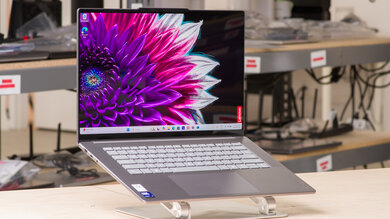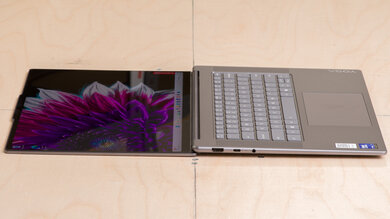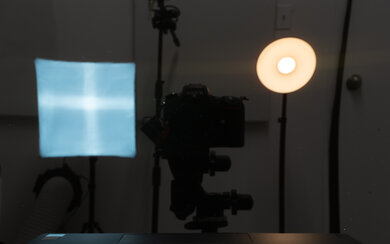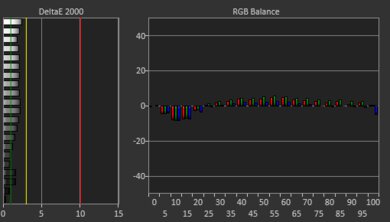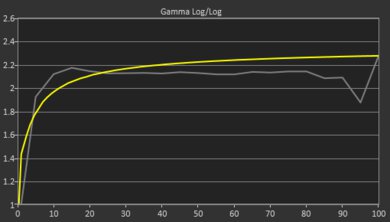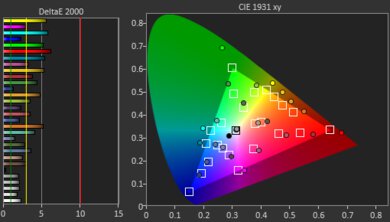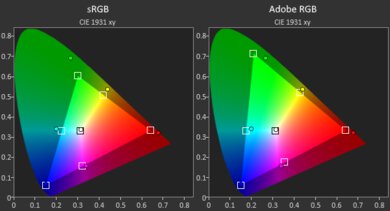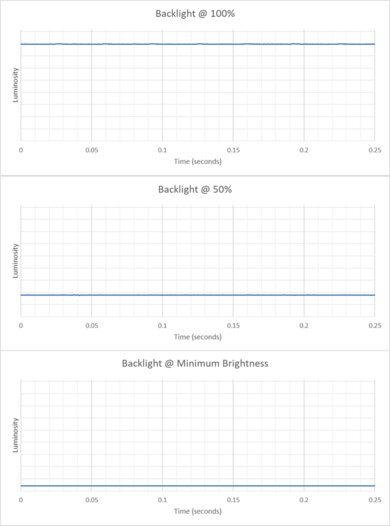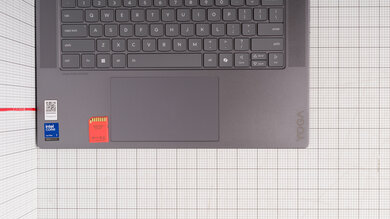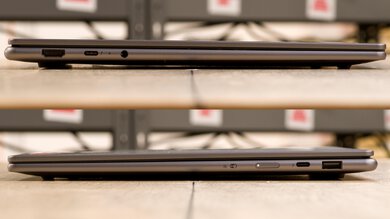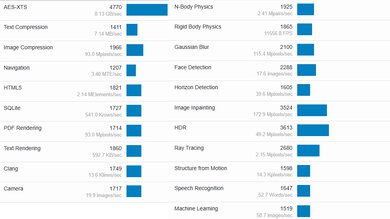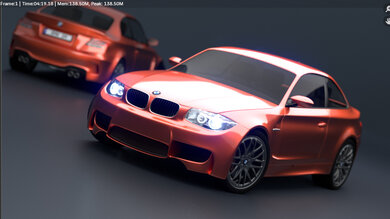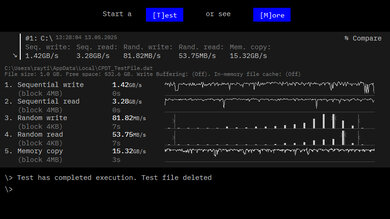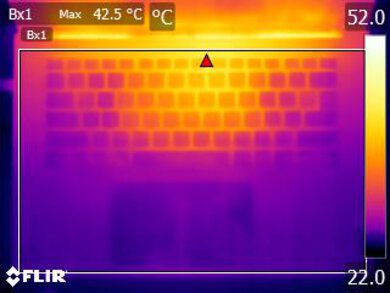The Lenovo Yoga Slim 7i Aura Edition 15 (2024) is a 15.3-inch Windows ultraportable laptop featuring Intel Lunar Lake SoCs. It's configurable with 16GB or 32GB of RAM and up to 1TB of storage. Display options include an IPS and an OLED panel; both have the same 2.8k resolution and 120Hz refresh rate, though only the IPS panel supports touch input, and the OLED panel is only available outside of North America. This laptop also has a 1080p webcam with Windows Hello facial recognition support and Wi-Fi 7 wireless connectivity. Ports comprise a USB-A, two USB-C/Thunderbolt 4s, an HDMI 2.1, and a headphone jack.
See our unit's specifications and the available configuration options in the Differences Between Variants section.
Note: We performed the productivity benchmarks, gaming benchmarks, thermals and noise, and performance over time tests using the Performance power mode instead of the default Adaptive (Auto) mode. This change makes the results more representative of the laptop's maximum potential and brings them closer to user expectations. However, this also means that the results are only comparable with reviews containing this disclaimer, as we previously tested laptops in their default mode, which usually throttles performance to prolong battery life.
Our Verdict
The Lenovo Yoga Slim 7 is great for school use. It's easy to carry for a 15-inch device, and its battery lasts around 11 to 12 hours for light uses, which is enough to get you through a typical school day with charge to spare. The user experience is excellent; you get a bright 2.8k display, a comfortable keyboard, and a good number of ports. The touchpad tracks all movements and gestures well, but its actuation feels shallow and mushy. Performance-wise, its Intel SoC can easily handle general productivity workloads like web browsing, text processing, and video playback. You can do some moderately intensive workloads, like programming and photo editing; however, you're better off getting a workstation or gaming laptop if you need to perform highly demanding tasks like 3D animation or simulations.
Easy to carry.
Battery lasts around 11 to 12 hours of light use.
Sharp, bright 2.8k display.
Comfortable keyboard, large touchpad.
Great port selection.
Touchpad clicks feel shallow and mushy.
CPU and integrated GPU can't handle highly demanding workloads.
Glossy display struggles with bright reflections.
The Lenovo Yoga Slim 7 isn't designed for gaming. While its Lunar Lake SoC's integrated GPU can handle some games at 1080p, you'll have to play with fairly low graphical settings to get playable frame rates, and some highly demanding titles likely won't run at all. This laptop is available with a 120Hz IPS or OLED panel; the former has a somewhat slow response time, causing visible ghosting, and neither supports FreeSync nor G-SYNC to reduce screen tearing. On the bright side, the laptop never gets hot or loud under load.
120Hz display.
User-replaceable storage drive.
Doesn't get hot or loud under load.
CPU and integrated GPU can't handle highly demanding workloads.
Display has slow response time.
No VRR support to reduce screen tearing.
The Lenovo Yoga Slim 7 is great for media consumption. It's very portable for a 15-inch device, and its battery lasts around 10 hours of local video playback, giving you plenty of time to get through multiple movies and TV show episodes. You can get this laptop with a 2.8k IPS or OLED display; the latter will deliver a better viewing experience, especially in dark rooms and HDR content, but keep in mind that the OLED likely flickers, which might bother some people, causing eye strain. The speakers sound clear and well-balanced, with a good amount of bass. They get very loud but sound a bit harsh at higher volume levels.
Easy to carry.
Sharp, bright 2.8k display.
Speakers sound well-balanced, with a good amount of bass.
Available with OLED display for better dark room viewing experience.
Battery lasts around 10 hours of local video playback.
Speakers sound harsh at high volume levels.
Glossy display struggles with bright reflections.
The Lenovo Yoga Slim 7 isn't designed for use as a workstation laptop. Its Intel Lunar Lake SoC is a low-power chip that can only handle light to moderately demanding tasks. Also, you can only get up to 32GB of soldered RAM, which isn't enough for highly intensive workloads. You can do some color-correction work, as both available displays have full sRGB and DCI P3 coverage. Thermal throttling is minimal, and the laptop doesn't get hot or loud under load.
User-replaceable storage drive.
Doesn't get hot or loud under load.
Display is suitable for some color-critical work.
CPU and integrated GPU can't handle highly demanding workloads.
Can only get up to 32GB of soldered RAM.
The Lenovo Yoga Slim 7 is great for business use. It has a sturdy build, a compact design, and a battery that lasts around 11 to 12 hours in light uses, making it ideal for those who travel a lot for work. Its bright 2.8k display gives you plenty of room for split-screen multitasking, and its keyboard feels comfortable to type on for long periods. The touchpad's actuation feels rather mushy, though, and the webcam's video quality is only decent, as the image looks noisy. Performance isn't a problem; its Intel Lunar lake SoC can easily handle productivity tasks like text processing, web browsing, spreadsheets, and presentations. You can also do some light video editing as long as the project isn't too complex, which is great for small business owners needing to produce their own ads.
Easy to carry.
Battery lasts around 11 to 12 hours of light use.
Sharp, bright 2.8k display.
Comfortable keyboard, large touchpad.
Great port selection.
Touchpad clicks feel shallow and mushy.
Glossy display struggles with bright reflections.
Changelog
-
Updated Aug 13, 2025:
Added mention of the ASUS Zenbook S 16 UM5606 (2024) as an alternative with pen input support in the Extra Features section.
-
Updated Jun 09, 2025:
Added mention of the ASUS Zenbook A14 UX3407 (2025) as an alternative with a longer battery life in the Battery section.
- Updated May 27, 2025: Review published.
- Updated May 21, 2025: Early access published.
Check Price
Differences Between Sizes And Variants
We tested the Lenovo Yoga Slim 7i Aura Edition 15 (model 15ILL9) with a 120Hz 2.8k IPS display, an Intel Core Ultra 7 256V SoC, and 1TB of storage. The display, SoC, and storage are configurable; see below for the available options.
SCREEN
- 15.3" IPS 2880 x 1800 120Hz (glossy, touchscreen, 500 cd/m², 100% DCI P3)
- 15.3" OLED 2880 x 1800 120Hz (glossy, 500 cd/m², 100% DCI P3, only available outside of North America)
SoC
- Intel Core Ultra 7 256V (8 cores/8 threads, up to 4.8GHz, 12MB cache, Arc Graphics 140V, 16GB RAM)
- Intel Core Ultra 7 258V (8 cores/8 threads, up to 4.8GHz, 12MB cache, Arc Graphics 140V, 32GB RAM)
MEMORY
- 16GB LP-DDR5x 8533MHz (soldered, Core Ultra 7 256V)
- 32GB LP-DDR5x 8533MHz (soldered, Core Ultra 7 258V)
STORAGE
- 512GB M.2 2242 PCIe Gen 4 NVMe SSD
- 1TB M.2 2242 PCIe Gen 4 NVMe SSD
COLOR
- Luna Gray
See our unit's label.
Popular Laptop Comparisons
The Lenovo Slim 7i is a great ultraportable overall. While the Yoga 7 is technically a tier below the Yoga 9 series in Lenovo's lineup, this Slim 7i model sits in the premium range, competing directly against other high-end models like the Apple MacBook Air 15 (M4, 2025) and the ASUS Zenbook 14 OLED (2024). The Yoga Slim 7i holds up well against these models, offering a display with a higher refresh rate than the MacBook Air 15's Retina screen, as well as a wider port selection and a user-replaceable storage drive. It also has a longer battery life than the Zenbook and doesn't throttle nearly as much under load. Its Intel Lunar Lake SoC's performance doesn't really stand out compared to other current-gen chips, lagging behind Apple's M4 SoC, but it's likely satisfactory for most people with a light, general productivity workload. Finally, the use of a diving board touchpad is a little disappointing, as many laptops in its class have adopted a haptic touchpad.
For more options, check out our recommendations for the best lightweight laptops, the best Windows laptops, and the best ultrabooks.
The Lenovo Yoga Slim 7i Aura Edition 15 (2024) and the ASUS Zenbook 14 OLED (2024) are both high-end ultraportables that deliver a similarly premium user experience. The Lenovo has a slightly larger screen that makes split-screen multitasking feel less cramped, and its battery life is noticeably better, lasting around three hours longer. However, the ASUS' touchpad feels more tactile, as its actuation provides a more satisfying click. You can also use its touchpad as a virtual numpad, which is handy if you work with lots of numbers. For those sensitive to display flicker, the Lenovo is a better choice, as it has a flicker-free IPS display option, while the ASUS is only available with OLED panels that flicker.
The ASUS Zenbook A14 UX3407 (2025) and the Lenovo Yoga Slim 7i Aura Edition 15 (2024) are both great ultraportables. In terms of user experience, the Yoga Slim 7i comes out ahead; it has a sturdier build, a sharper, brighter screen, and a more comfortable keyboard with longer travel keys. However, the Zenbook A14 is more portable, and its battery life is in a league of its own, lasting almost eight hours longer than the Yoga Slim 7i. One thing to keep in mind about the Zenbook A14 is that it's an ARM-based model using a Qualcomm Snapdragon SoC. This means some apps might not work or will run poorly, so make sure the apps you use work first.
The Lenovo Yoga Slim 7i Aura Edition (2024) and the Apple MacBook Air 15 (M4, 2025) are both premium ultraportables. Each has its pros and cons. The MacBook Air has a sturdier build, a more tactile haptic touchpad, and a higher-quality webcam. Also, its M4 SoC is faster, providing a snappier desktop experience overall. The MacBook Air is also fanless, though the Yoga Slim 7i doesn't get very loud under load. As for the Yoga Slim 7i, it has more ports, and its storage drive is user-replaceable, making it much cheaper to increase storage space. The Yoga Slim 7i's displays have a 120Hz refresh rate, whereas the MacBook Air's Retina display is limited to 60Hz; however, this difference likely won't matter much if you mainly look at static content like documents and spreadsheets. You can get the Yoga with an OLED display, which delivers deeper blacks than the MacBook Air's Retina display, but remember that the OLED flickers, which might bother some people.
The Lenovo ThinkPad X9 15 Aura Edition (2025) and the Lenovo Yoga Slim 7i Aura Edition (2024) are both ultraportables featuring Intel Lunar Lake chips, delivering nearly identical performance. However, the ThinkPad X9 is an even more premium device, sporting a sturdier build, a haptic touchpad, and a better 1440p webcam. The X9 also has a better battery life, lasting nearly four hours longer in light uses. That said, if you're sensitive to display flicker, know that the X9 is only available with OLED displays that flicker at 480Hz, while the Yoga Slim 7i has a flicker-free IPS panel option.
Test Results

The Lenovo Yoga Slim 7 is only available in the Luna Gray colorway. See the bottom of the laptop.
The Lenovo Slim 7i's build quality is excellent. Its full-aluminum chassis feels very sturdy, exhibiting only a small amount of flex on the lid and keyboard deck. The finish doesn't pick up many fingerprints or smudges; minor scratches appear with regular use, but a quick wipe with a microfiber cloth buffs them away almost completely. The feet feel solid and stick firmly to the bottom.
The hinge is okay. While it feels smooth when opening and closing the lid, it has far too much resistance to allow for a one-handed lift. The screen doesn’t wobble when typing heavily; it does when using touch input near the top of the screen, but the wobbling isn’t bad enough to be an issue.
Accessing the Lenovo Slim 7i Aura Edition's internals is straightforward; you only need to remove five torque screws and release the bottom panel's clips with a prying tool. The storage slot supports M.2 2242 PCIe Gen 4 NVMe SSDs.
See the maintenance manual on Lenovo's support page.
The Lenovo Slim 7i is available with the following displays:
- 15.3" IPS 2880 x 1800 120Hz (glossy, touchscreen)
- 15.3" OLED 2880 x 1800 120Hz (glossy)
The 2.8k resolution looks very sharp on a 15.3-inch screen—you would have to be a few inches from the screen to see individual pixels. The 16:10 aspect ratio is well-suited for productivity; it gives you more vertical space than a standard 16:9 screen, allowing you to see more information at once when reading a document, so you don't have to scroll as much. The OLED panel (available only outside of North America) will provide a better visual experience, but keep in mind that OLEDs are susceptible to permanent burn-in, especially with static desktop elements like Windows' taskbar.
Both panels have a 120Hz refresh rate and Dynamic Refresh Rate support. The latter allows the display to vary the refresh rate between 60Hz and 120Hz depending on whether you're actively using the laptop or looking at static content. Dynamic Refresh Rate isn't the same as FreeSync or G-SYNC, so you'll likely still see screen tearing when gaming. The IPS panel's response time is okay; there's visible ghosting behind fast-moving objects, though it's relatively minimal considering this is primarily a productivity laptop. The OLED likely has a faster response time, as most OLEDs do.
The IPS display's contrast ratio is decent and within the typical range of most IPS panels; however, it's still low compared to other display technologies. This contrast level makes blacks look gray in dim settings. The OLED panel's contrast ratio is effectively infinite since OLEDs can turn off individual pixels to produce perfect blacks.
The IPS display gets bright enough for use in most indoor settings. Outdoor use is possible, but you may have trouble seeing some content in sunny conditions, as the display's glossy finish doesn't handle direct reflections all that well. The panel gets very dim at the lowest brightness setting, which is great for dark room viewing as it causes less eye strain. The OLED panel has the same advertised brightness.
The display's reflection handling is okay. Its glossy finish mainly struggles with bright light sources, like a lamp or open window during the day. These reflections are visible even with the screen at maximum brightness. The OLED panel has the same glossy finish.
The IPS panel's out-of-the-box accuracy is great. Most white balance inaccuracies are minor and hard to spot. The Color dE is a little high, mainly because the panel targets a wider color space by default, resulting in oversaturation. The gamma doesn't follow the curve all that well; most scenes look too bright, while dark scenes look too dark.
The IPS display has an outstanding color gamut. It has full coverage of the sRGB and DCI P3 color spaces, making it suitable for general media consumption and some content creation. Its Adobe RGB coverage is excellent, but it likely still isn't enough for photography professionals, as it's missing the highly saturated greens that define Adobe RGB. The OLED panel has the same advertised color gamut.
The Lenovo Yoga Slim 7i has an excellent keyboard. Its layout feels spacious and is easy to get used to. Typing feels very comfortable; the keys have a good amount of travel, are easy to actuate, and provide clear, satisfying tactile feedback. Key stability is great for the most part; only a few keys wobble slightly. You can toggle between two backlight brightness levels or set it to 'Auto' using Fn + Space Bar. The backlight is white and shines well through the legends.
The Lenovo Yoga Slim 7i Aura Edition's touchpad is large and responsive to all movements and gestures. Palm rejection works as intended, and there are no issues with actions like dragging and dropping or zooming in and out of images. This is a diving board touchpad, so you can only click in the bottom half of the touchpad. Unfortunately, the actuation feels shallow and mushy.
The Lenovo Slim 7i has a quad-speaker system with two drivers flanking the keyboard and two more at the bottom of the laptop, near the front. The speakers sound relatively full and well-balanced, with a good amount of bass and instrument separation. They get very loud, though there's compression at max volume, causing some harshness in the sound.
The webcam is decent. The image has a fair amount of fine details, but it's quite noisy throughout, even in brighter areas. There's a slight greenish tint, and the colors look a tad washed out. Voices sound loud and clear; the microphone picks up some background noise, but only when it's recording your voice. There's no physical privacy cover, only a toggle on the side of the laptop to disable the camera at the software level.
The Lenovo Slim 7i has a great port selection. The USB-A port supports USB 3.2 Gen 1 data transfer speed of 5Gbps. Both USB-Cs support Thunderbolt 4/USB4 data transfer speed of 40Gbps, DisplayPort 2.1, and Power Delivery 3.1. The HDMI port’s advertised maximum output resolution is 4k @ 60Hz; however, we can confirm that it can output a 4k @ 120Hz signal.
The Lenovo Slim 7i's wireless adapter is an Intel Wi-Fi 7 BE201. Like Wi-Fi 6E, Wi-Fi 7 gives you access to the 6GHz band but with even faster speeds and lower latency. However, you need a router that supports Wi-Fi 7 to benefit from these features. Check out our best router recommendations if you want to upgrade your wireless setup.
The Lenovo Slim 7i is available with the following SoCs:
- Intel Core Ultra 7 256V (8 cores/8 threads, up to 4.8GHz, 12MB cache, Arc Graphics 140V, 16GB RAM)
- Intel Core Ultra 7 258V (8 cores/8 threads, up to 4.8GHz, 12MB cache, Arc Graphics 140V, 32GB RAM)
Both are low-power processors designed for general productivity tasks like web browsing, text processing, spreadsheets, and video playback. Unlike previous Intel chips, these Lunar Lake processors are proper SoCs (System on Chip) with the RAM built in. The 256V and the 258V are the same chip with identical clock speeds and core composition (four performance and four efficiency). The only difference is their memory size—16GB and 32GB, respectively—so the choice comes down to the amount of RAM you need for your workload. Another change is the lack of Hyper-Threading, resulting in slightly slower multi-thread performance compared to Meteor Lake CPUs. These SoCs have an NPU (Neural Processing Unit) with a rated performance of 47 TOPS (Trillions of Operations per Second) to handle AI tasks, like Windows Copilot, image generation in photo editing apps, and background-blurring on video calls.
The Lenovo Slim 7i is only available with Intel's Arc Graphics 140V, an integrated GPU designed primarily for light productivity tasks. The 140V is faster than previous Intel integrated graphics, at least on the gaming side. That said, it's still noticeably behind older, entry-level discrete GPUs like the NVIDIA GeForce RTX 3050 Laptop GPU. It can handle lighter games at 1080p, but you'll have to play with relatively low settings to get playable frame rates.
You can get this laptop with 16GB or 32GB of RAM. However, as mentioned in the CPU section, you can only get 16GB if you get a model with a Core Ultra 7 256V SoC, while 32GB is only available on models with a Core Ultra 7 258V SoC. The RAM isn't user-replaceable.
You can configure this laptop with 512GB or 1TB of storage. The storage is user-replaceable; the slot supports M.2 2242 PCIe Gen 4 NVMe SSD.
The Lenovo Slim 7i's Intel Core Ultra 7 256V SoC scores well in the Geekbench 5 benchmarks. Though not the fastest power-efficient chip of its generation, it's still plenty fast for most common, everyday tasks. There are much faster processors on the market if you have a demanding workload, like Apple's M4 SoC or the Intel and AMD HX chips, typically found in gaming laptops and workstations.
As for GPU performance, although the new Arc Graphics are better than previous generation integrated GPUs from Intel, they're still pretty weak compared to current-gen entry-level discrete GPUs, at least when it comes to non-gaming, computing tasks.
While the Intel Core Ultra 7 256V SoC's performance is great for a power-efficient chip in a thin, thermally limited chassis, it doesn't really stand out, as it lags behind its Intel Meteor Lake predecessors and Apple's M4 SoC. This performance level is suitable for light to moderately intensive workloads but not ideal for highly demanding tasks. For the latter, you're better off getting a workstation or gaming laptop, like the Razer Blade 18 (2024) or the Apple MacBook Pro 16 (2024).
The Intel Lunar Lake SoC's integrated Arc Graphics 140V scores decently well in the Basemark GPU benchmarks. This performance level is almost in the same ballpark as an NVIDIA GeForce GTX 1650 (mobile), an entry-level discrete GPU first launched in 2019. It can handle some demanding games at 1080p, but you'll have to lower the graphical settings to get playable frame rates.
Check out the ASUS Zenbook A14 UX3407 (2025) if you want a Windows ultraportable with a longer battery life.
Borderlands 3 runs poorly at 1080p on the Lenovo Slim 7i. Although you can get over 60 fps with low settings, the gameplay is extremely choppy due to frame drops. Lowering the resolution to 720p will likely reduce the stuttering but won't completely fix it.
The Intel Lunar Lake's integrated graphics run Civilization VI and other similarly demanding strategy games smoothly at 1080p, as these types of games typically don't require a lot of GPU processing power. The average turn time is slow, though, even against the same chip in the HP OmniBook Ultra Flip 14 (2024).
Counter-Strike 2 isn't really playable at 1080p. Although you can get well over 60 fps with some tweaks in the settings, there are frequent stutters due to frame drops, which isn't ideal for an FPS game. Lowering the resolution helps but doesn't completely fix the problem.
Shadow of the Tomb Raider is somewhat playable at 1080p on the Lenovo Yoga Slim 7i Aura. You can get over 60 fps by tweaking the graphical settings, but you'll likely experience some stutters in busy scenes. The large frametime spikes are scene changes and aren't representative of the performance.
The keyboard is only mildly warm under load, not enough to cause discomfort. Using the laptop on your lap shouldn't be a problem either, as the bottom only reaches 42.2 °C (107.96 °F).
The posted results are measurements taken in the Performance power mode. You can change the power mode via the Lenovo Commercial Vantage app.
The Lenovo Slim 7i has many pre-installed applications; see this video for the full list.
The Lenovo Yoga Slim 7i has a Windows Hello facial recognition camera. You can use it to log in quickly, authorize purchases in the Windows Store, and auto-fill saved passwords on supported websites.
Check out the ASUS Zenbook S 16 UM5606 (2024) if you want a similar laptop with pen input support.

